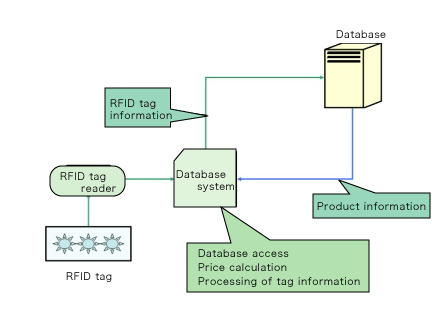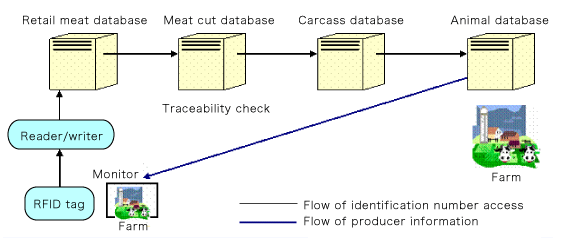RFID tag traceability research
RFID tags
RFID tags can be attached to people, animals and objects and identify themselves through radio communication. They consist of an IC chip and antenna to allow radio communication and range in size from large examples the size of a postage stamp, to smaller models which can be 5-6mm square. This technology is currently being used in various fields.
RFID tag applications
Currently in supermarkets and convenience stores prices are tracked using either manual or barcode entry systems. However manual systems are time-consuming and barcode systems require the manual alignment of the codes so that they can be read by the cash register. RFID tags can complete these processes automatically using radio communication. The technology allows for the automatic processing of a large number of tags within the area of the radio range in less than a second. Unlike barcodes, RFID tags do not need to be on the surface of the product in order to be read, allowing them to be inside packaging or the cover of a book. Many tags can also be read at the same time, even when they are under other goods.
Additional RFID tag applications
There are many other potential applications for RFID tags. They have recently been used in the automatic tracking of books in lending libraries. Because RFID tags can be read remotely, library staff can check the inventory of books simply by walking past a shelf while holding the reader. This greatly reduces the time involved in the inventory process. Additionally, if anyone tries to illicitly remove a book from the library, readers at the exit can alert library staff.
Our research
We are currently conducting research into traceability systems for the use of RFID tags in agriculture, seafood and meat processing in order to allow the tracing of products by consumers from their production to their retail. The following figure shows the use of such a system to store and access details of the origin and processing of food products on a database: allowing the management of production, stock and shipment through to product pricing at the retail outlet.

The following figure shows an RFID tag system for tracking meat that allows the monitoring of details by the consumer through the fixing of RFID tags to the meat and packaging and subsequent processing with a reader/writer. This can include information about the individual animal, the producer (including photographs of the farmer and farm), animal feed data and distribution path.


